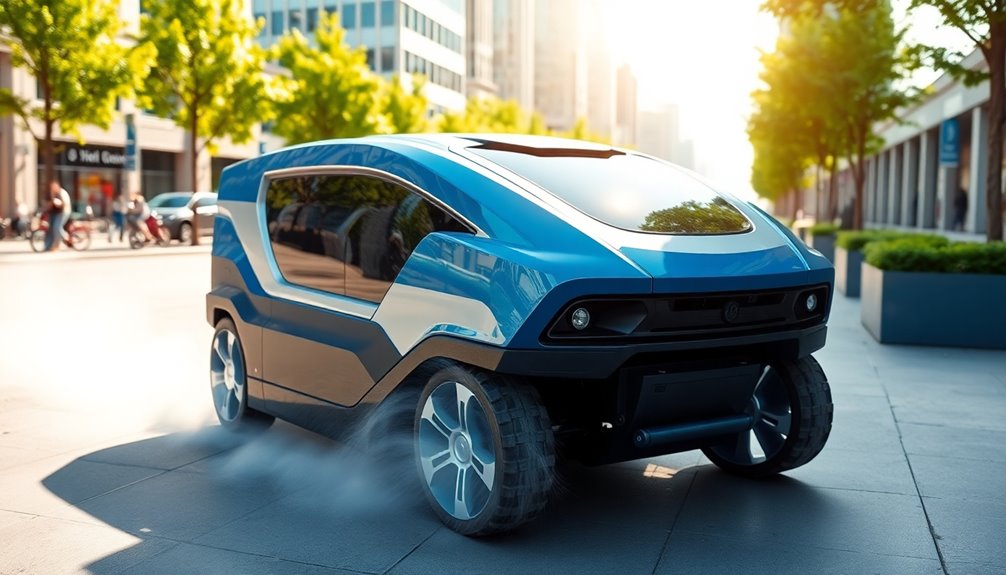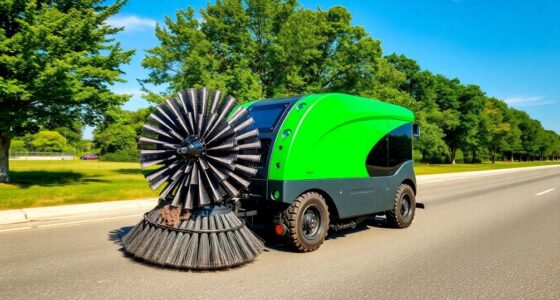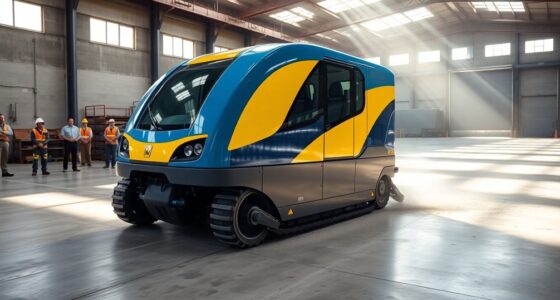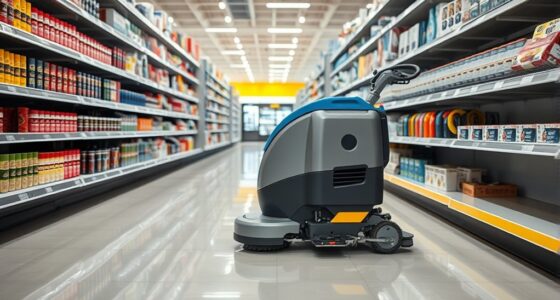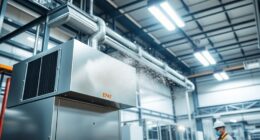You'll notice that commercial sweeper machines are incorporating incredible innovations like automation and robotics, making cleaning faster and more efficient. Battery-powered models are gaining traction, offering zero emissions and lower operational costs. Real-time monitoring through IoT technology enhances performance and maintenance. With advanced filtration and waste management solutions, these machines help meet sustainability goals. Curious about more cutting-edge developments? There are plenty of advancements shaping the future of commercial cleaning equipment.
Key Takeaways
- Robotic sweepers like the RB75i utilize smart sensors for optimized cleaning, enhancing operational effectiveness and navigating hard-to-reach areas.
- Real-time monitoring through IoT devices allows for continuous data collection, improving service efficiency and enabling predictive maintenance.
- Battery-powered cleaning machines produce zero emissions and are favored for their long-term cost savings and quiet operation.
- Advanced cleaning technologies, such as electrostatic disinfection and smart trash monitoring, ensure thorough cleaning and efficient waste management.
- Sustainable practices, including the use of biodegradable cleaners and recycled materials, align with eco-friendly initiatives in the cleaning industry.
Automation and Robotics in Commercial Sweepers
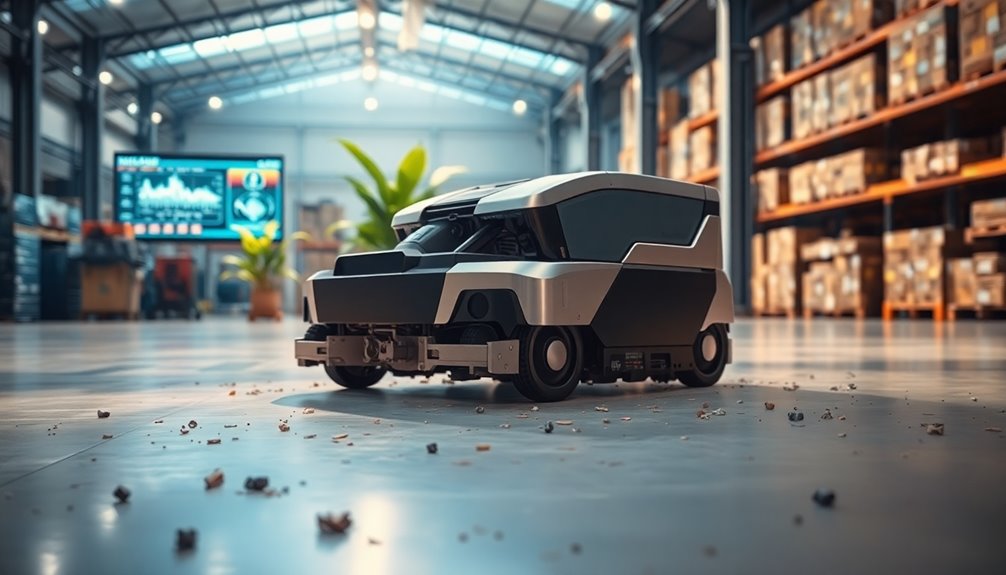
As the cleaning industry evolves, automation and robotics in commercial sweepers are transforming how facilities maintain cleanliness and efficiency.
The introduction of robotic sweepers, like the RB75i, showcases this shift, enhancing operational effectiveness and tackling labor shortages. Automated systems use smart sensors and data analytics to optimize cleaning routes and schedules, ensuring a thorough clean every time.
These robotic sweepers can navigate hazardous or hard-to-reach areas, minimizing human error and boosting safety. Additionally, their ability to continuously monitor performance metrics means you can enjoy predictive maintenance, reducing downtime.
Data Connectivity and Real-Time Monitoring
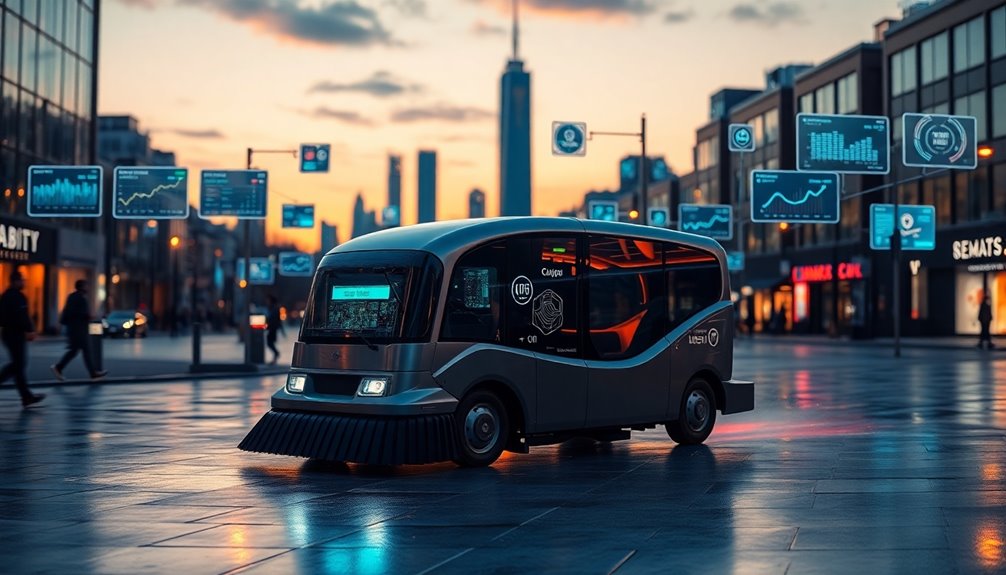
Data connectivity in commercial sweeper machines lets you monitor operations in real time, making it easier to boost efficiency.
With predictive maintenance insights, you can catch potential issues before they cause costly downtime.
This proactive approach not only keeps your machines running smoothly but also helps optimize your cleaning processes.
Enhanced Operational Efficiency
Enhanced operational efficiency in commercial sweeper machines hinges on the power of data connectivity and real-time monitoring.
With technology innovations like Hako's fleet management system, you can gain valuable insights into machine usage and performance. This allows you to make informed decisions and adjust cleaning schedules for maximum productivity.
Real-time tracking not only helps you optimize routes but also supports predictive maintenance, reducing downtime by catching potential issues early.
Plus, the integration of IoT devices guarantees continuous data collection, fostering ongoing improvements in your cleaning processes.
Ultimately, leveraging data-driven analytics leads to significant cost savings, improving fuel consumption and operational time for your cleaning fleet, guaranteeing you achieve the highest level of operational efficiency.
Predictive Maintenance Insights
While predictive maintenance offers a proactive approach to managing your commercial sweeper machines, it relies heavily on data connectivity and real-time monitoring. By leveraging data analytics, you can identify potential equipment failures before they happen, reducing downtime and costs. Real-time systems collect essential data on usage and performance, allowing you to enhance operations effectively.
| Feature | Benefit |
|---|---|
| Data Analytics | Predicts equipment failures |
| Real-Time Monitoring | Enhances operational efficiency |
| GPS Tracking | Improves routes and schedules |
| Performance Trends | Informs maintenance schedules |
| Cost Transparency | Supports sustainable management |
For cleaning companies, these insights lead to better decision-making and improved reliability of your fleet, ensuring peak performance and longevity.
The Rise of Battery-Powered Cleaning Machines
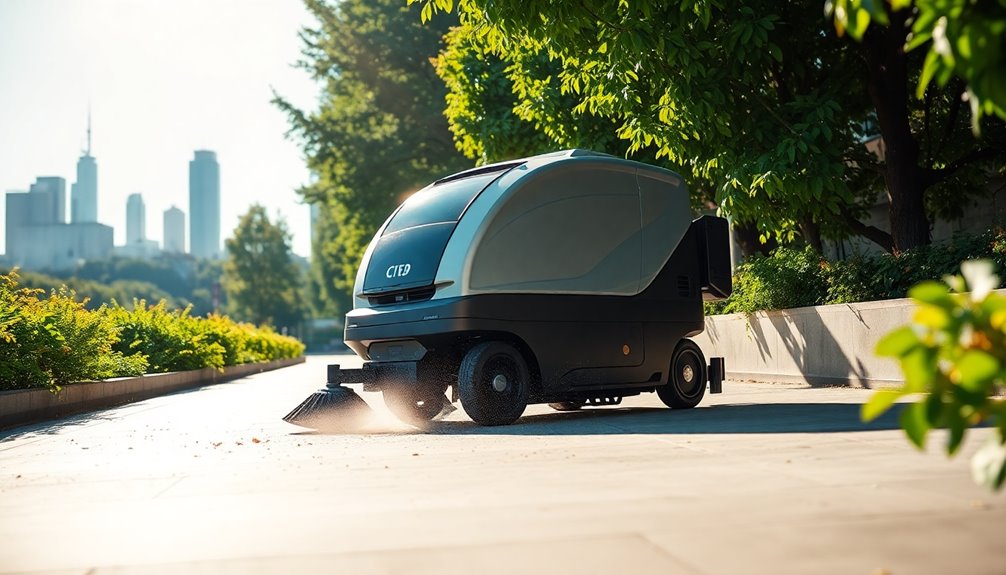
As you explore the rise of battery-powered cleaning machines, you'll notice their significant environmental benefits, including zero emissions and quieter operation.
These machines not only promote sustainability but also often lead to cost savings over time.
With market adoption trends shifting towards eco-friendly options, now's the perfect time to contemplate how these advancements can enhance your cleaning operations.
Environmental Benefits of Batteries
The rise of battery-powered cleaning machines marks a notable shift towards sustainability in urban environments, driven by public subsidies and energy efficiency initiatives.
These machines, like Hako's Citymaster, offer a reduced environmental impact by producing zero emissions and minimizing noise pollution compared to traditional fuel-powered models.
As you adopt battery technology, you'll find that these eco-friendly solutions not only align with corporate sustainability goals but also help you lower long-term costs through decreased energy consumption and maintenance.
While the market in China is still emerging, interest from government-owned companies indicates a growing commitment to sustainable practices.
Embracing battery-powered machines allows you to enhance operational efficiency while notably reducing your overall carbon footprint. Additionally, integrating energy-efficient systems can further optimize performance and sustainability in your operations.
Cost Efficiency Analysis
Battery-powered cleaning machines not only contribute to environmental sustainability but also offer significant cost advantages for businesses. By switching to these modern cleaning machines, you can enjoy notable cost savings while enhancing your cleaning operations.
- Eliminate fuel consumption costs
- Reduce maintenance expenses associated with combustion engines
- Benefit from public subsidies promoting energy efficiency
- Align with growing demand for efficient, sustainable solutions
As seen with Hako's Citymaster, cities are increasingly adopting battery-powered sweepers due to their operational cost savings and eco-friendly features. Additionally, adopting renewable energy technologies can further enhance the sustainability of these cleaning operations.
Even in regions like China, interest is rising among government-owned companies for these sustainable options.
Converting to battery-powered cleaning equipment reflects a commitment to both sustainability and long-term financial efficiency.
Market Adoption Trends
A notable shift is underway in the cleaning industry as more cities embrace battery-powered cleaning machines.
In Europe, public subsidies and energy efficiency initiatives are driving market adoption trends, making eco-friendly options like Hako's Citymaster increasingly popular. These machines not only align with sustainability goals but also enhance operational efficiency and cost control, capturing the interest of various industries.
Meanwhile, in China, the evolution to battery-powered machines is still in its infancy, hindered by a reliance on simpler technologies. However, government-owned companies are beginning to recognize the importance of sustainability, hinting at a future uptick in demand as the market matures.
Sustainability Initiatives in Cleaning Equipment
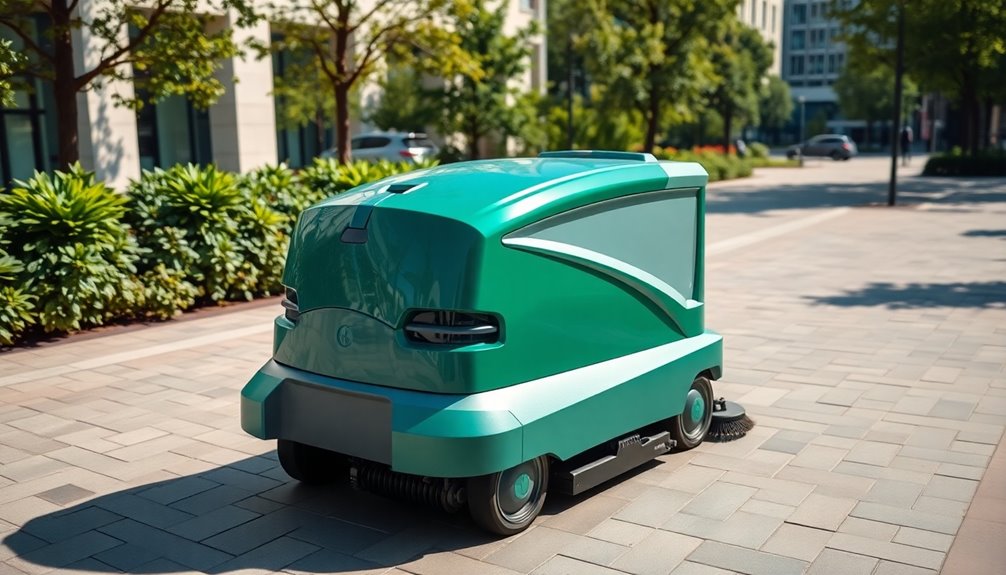
As companies increasingly prioritize sustainability, innovations in cleaning equipment reflect a strong commitment to eco-friendly practices.
You'll notice a trend towards battery-powered machines, driven by public subsidies and energy efficiency goals, especially in urban areas. Brands like Hako are leading the charge with machines designed for reduced energy consumption and component reuse.
Consider these sustainability initiatives in cleaning technology:
- Adoption of battery-powered models for lower emissions.
- Use of biodegradable cleaners to enhance environmental health.
- Integration of recycled materials in equipment manufacturing.
- Focus on circular economy practices to minimize waste.
These advancements not only improve operational efficiency but also contribute to a cleaner, healthier environment, aligning with the industry's commitment to sustainability. Additionally, the rise of smart home devices has influenced the development of more efficient cleaning machines that can be integrated into broader energy-saving systems.
Localisation Strategies for Diverse Markets
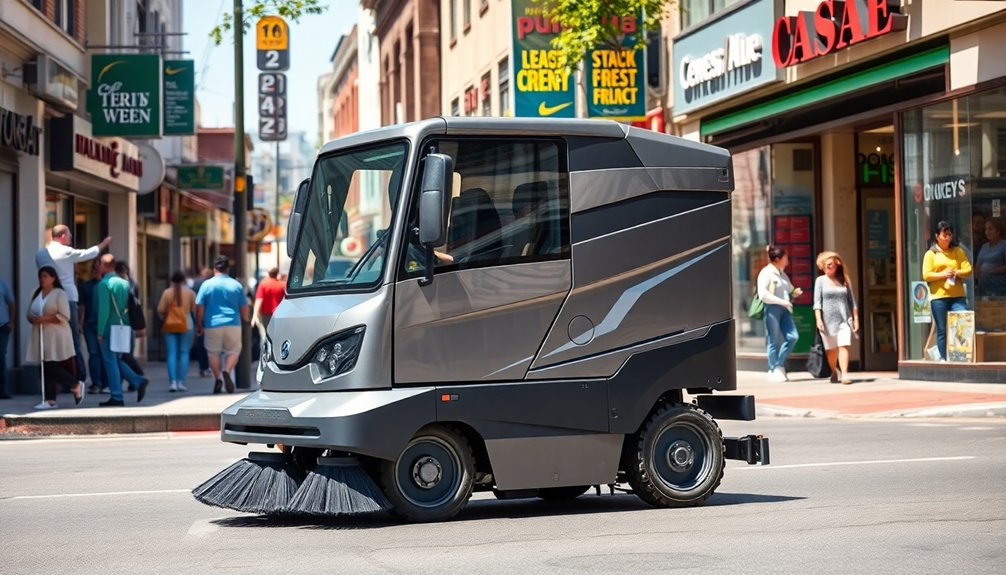
Localisation strategies are essential for companies like Hako that want to thrive in diverse markets. By tailoring products to meet local needs, you can effectively address the varying demands of regions like Europe and China.
For instance, while European customers may seek advanced machinery, Chinese markets often prefer simpler models. In China, features like automatic brush loading cater to older cleaning staff, emphasizing usability.
As the Chinese market matures, there's a growing demand for professional-grade cleaning machines, highlighting an important shift toward advanced solutions. Implementing successful localisation strategies allows you to align your offerings with regional preferences, enhancing your competitive advantage in the professional cleaning industry.
Adapting to local operational practices is key to achieving long-term success.
Advanced Technologies in Cleaning Solutions
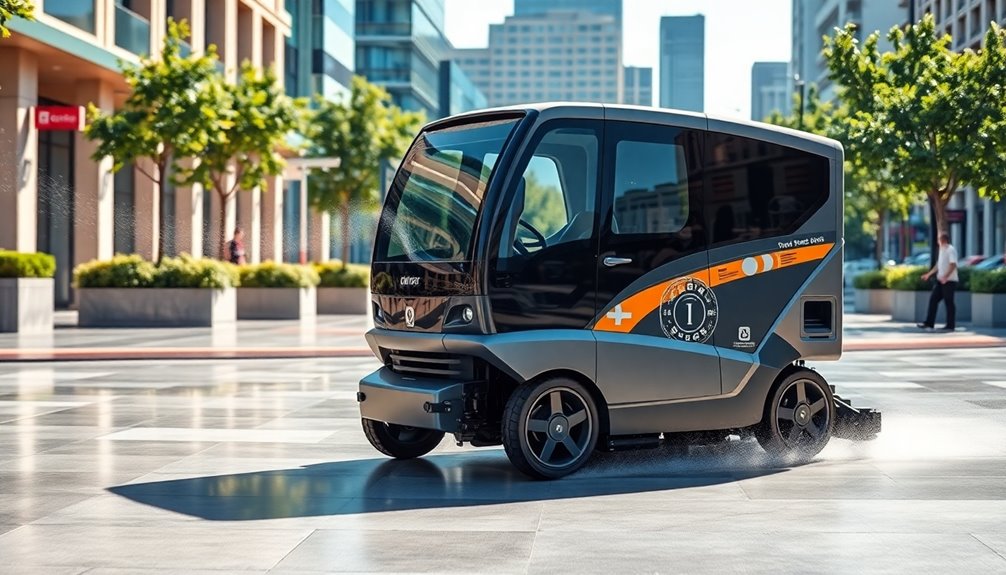
Understanding local market preferences is just the beginning; embracing advanced technologies in cleaning solutions can elevate your operations.
By integrating the latest trends, you'll not only enhance efficiency but also guarantee a cleaner environment.
- Utilize electrostatic disinfection for thorough sanitization.
- Adopt robotic scrubbers like the RB75i for automation and cost reduction.
- Choose battery-powered machines for sustainability and energy efficiency.
- Implement real-time monitoring systems for peak performance.
These advanced technologies are shaping the future of commercial cleaning.
With innovations like advanced filtration and dust control systems, you can meet air quality standards while minimizing environmental impacts.
Embrace these solutions today to stay ahead in the competitive market and deliver exceptional service.
Waste Management Innovations in Commercial Cleaning
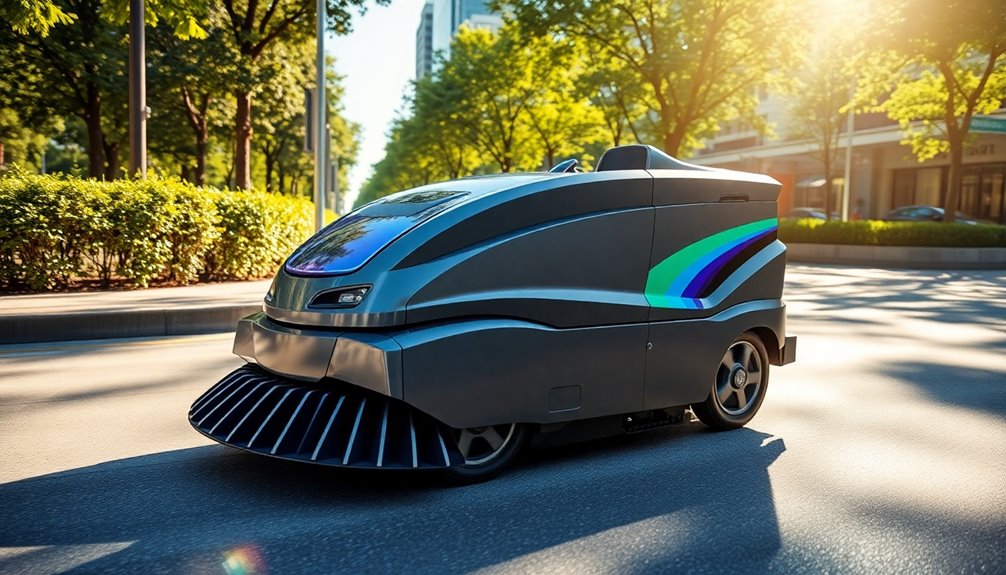
While innovative cleaning technologies are essential, effective waste management is equally important for enhancing sustainability in commercial cleaning. You can embrace greener practices by utilizing smart trash monitoring systems that optimize waste collection schedules, making operations more efficient. Composting strategies help manage organic waste and cut down carbon footprints. Implementing designated recycling bins for used paper towels further streamlines recycling efforts. Partnering with recycling facilities guarantees that materials are repurposed, reducing landfill contributions. Additionally, using biologically active tissue paper products helps prevent plumbing issues, contributing to sustainable waste management solutions. Furthermore, understanding the connection between UTIs and hallucinations can lead to better health assessments and waste management in facilities serving seniors.
| Waste Management Innovations | Benefits |
|---|---|
| Smart Trash Monitoring Systems | Optimizes collection schedules |
| Composting Strategies | Reduces carbon footprint |
| Designated Recycling Bins | Streamlines recycling process |
Performance Tracking and Efficiency Optimization
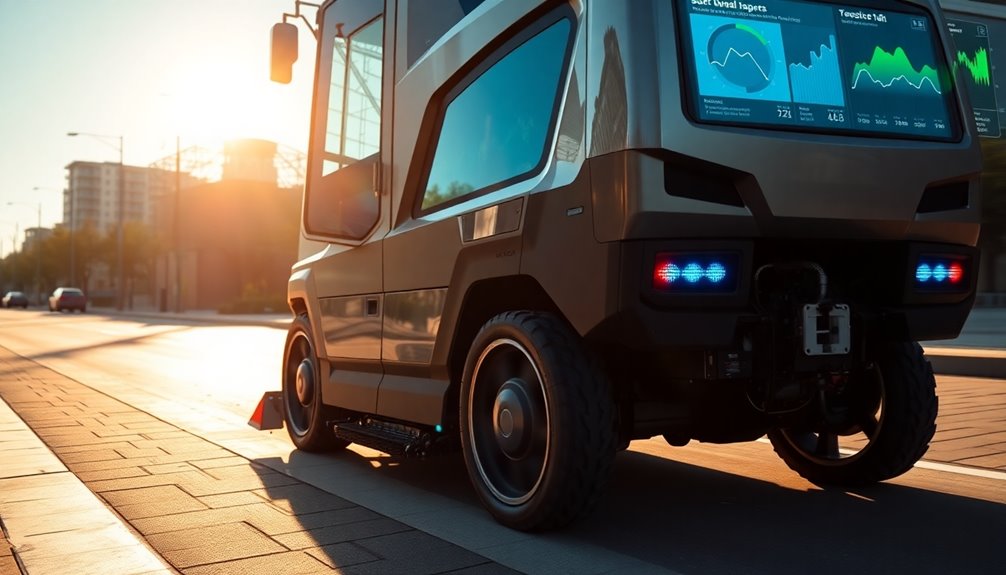
To achieve ideal efficiency in commercial cleaning, you need to harness the power of performance tracking and analytics. By collecting real-time data, you can monitor schedules and resources, leading to enhanced service efficiency.
Here's how you can optimize your operations:
- Make real-time adjustments for improved effectiveness.
- Identify effective cleaning techniques that save costs.
- Utilize GPS and telematics for better fleet management.
- Implement predictive maintenance to reduce downtime.
With these strategies, you'll find that performance tracking not only improves your cleaning methods but also enhances efficiency optimization.
This means you can deliver top-quality service while cutting operational costs, turning your commercial sweeping operations into a well-oiled machine.
Future Trends in Commercial Sweeping Technology
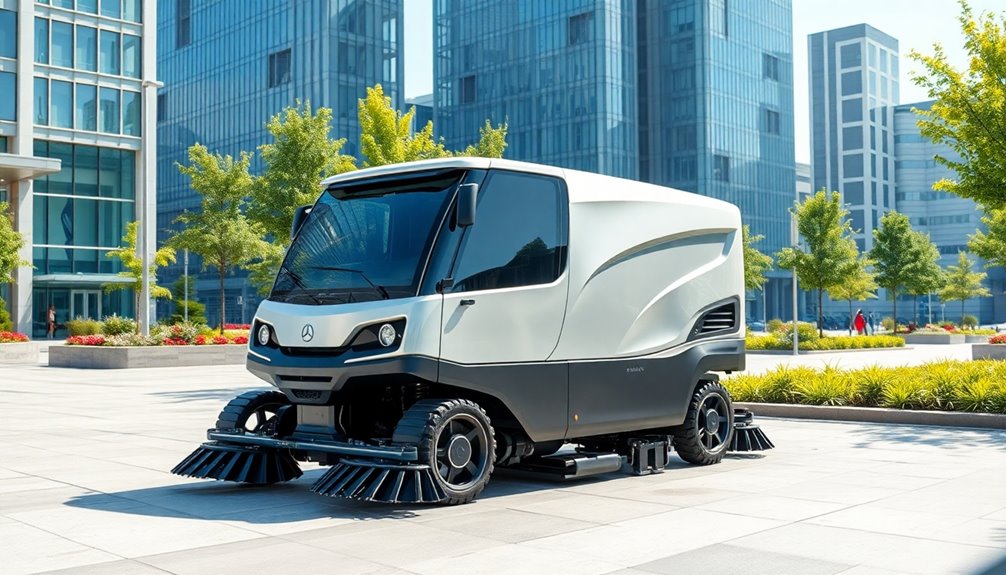
As the cleaning industry evolves, you'll find that embracing future trends in commercial sweeping technology is vital for staying competitive. Innovations like IoT integration allow for real-time monitoring and data analytics, optimizing your cleaning processes.
Battery-powered sweepers are gaining traction, especially in Europe, thanks to sustainability initiatives aimed at reducing emissions. Robotic sweepers, such as the RB75i, tackle labor shortages while delivering precision and consistency.
Additionally, electrostatic disinfection technology guarantees thorough sanitization, essential for high-sterility environments. You can also expect a focus on ergonomic designs and user-friendly interfaces, enhancing operator comfort and reducing fatigue during long shifts.
Frequently Asked Questions
What Is the Cleaning Industry Trend in 2024?
In 2024, you'll notice a strong shift towards battery-powered cleaning machines, propelled by sustainability efforts and public support.
You might also see more robotic solutions like the RB75i scrubber becoming popular due to labor shortages and rising costs.
Additionally, data-driven systems are helping optimize cleaning operations, while eco-friendly products gain traction.
As companies localize their offerings, you'll find machines tailored to specific market needs, especially in regions like China.
What Technology Is Used in Cleaning Services?
In cleaning services, you'll find technology like IoT devices for real-time monitoring, electrostatic disinfectants for thorough surface coverage, and automated equipment for precision.
You can also expect battery-powered machines that promote sustainability and data-driven solutions for operational efficiency.
These advancements not only enhance effectiveness but also streamline processes, reduce costs, and improve overall service quality.
Embracing these technologies keeps your cleaning operations competitive and responsive to modern demands.
Conclusion
As you explore the latest advances in commercial sweeper machines, it's clear that innovation isn't just a buzzword—it's a game changer. The integration of automation, battery power, and real-time data not only enhances efficiency but also aligns with sustainability goals. By embracing these technologies, you're not just keeping spaces clean; you're contributing to a greener future. So, immerse yourself in these innovations and see how they can transform your cleaning operations for the better!
